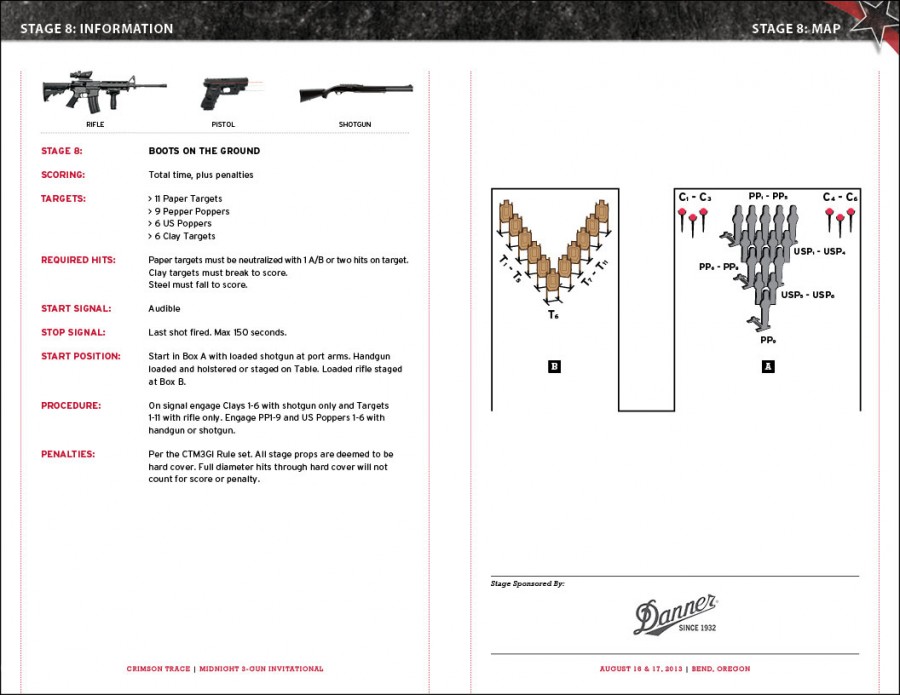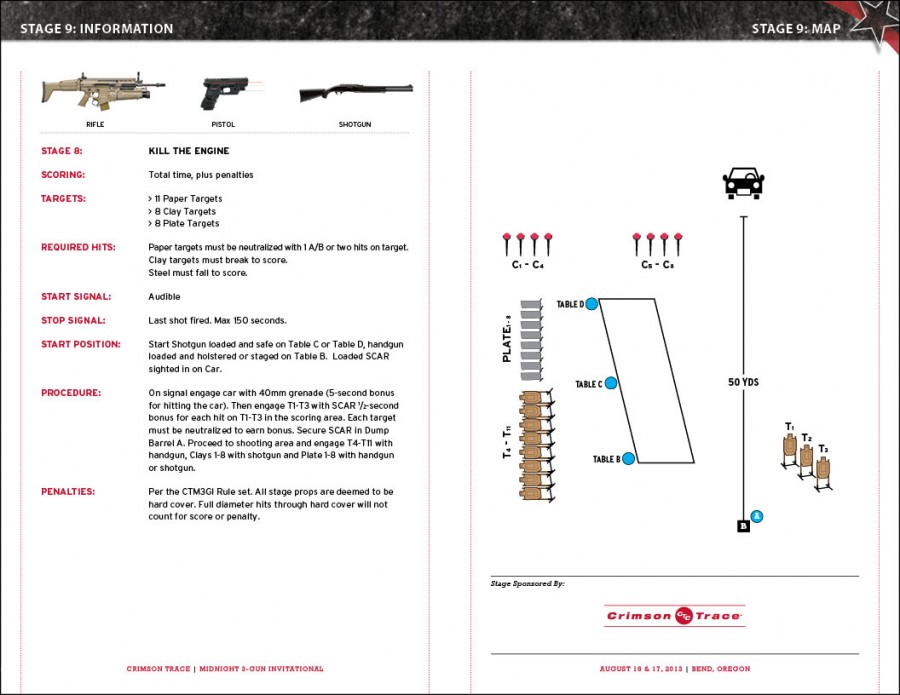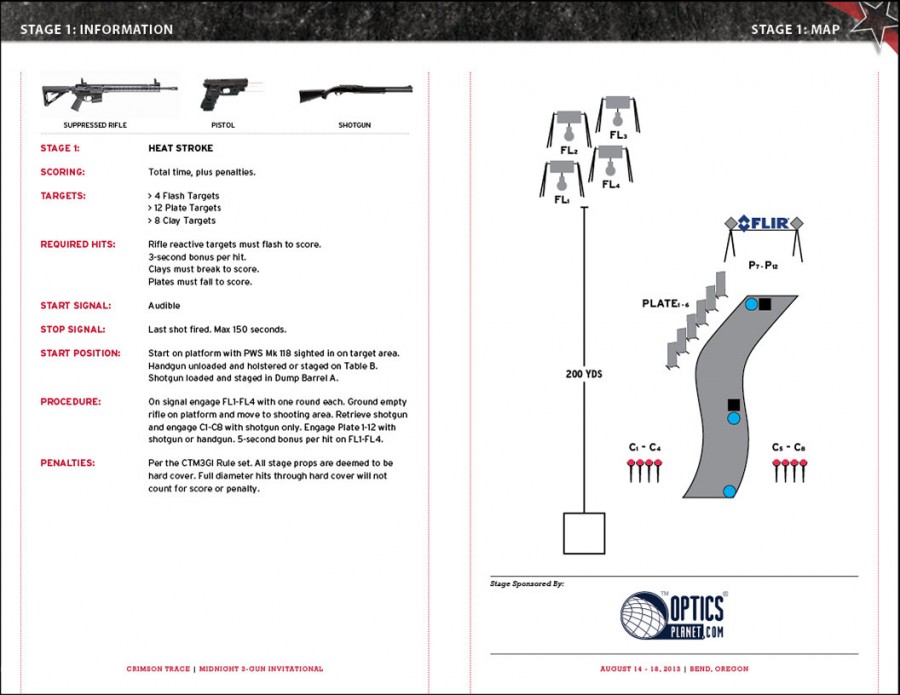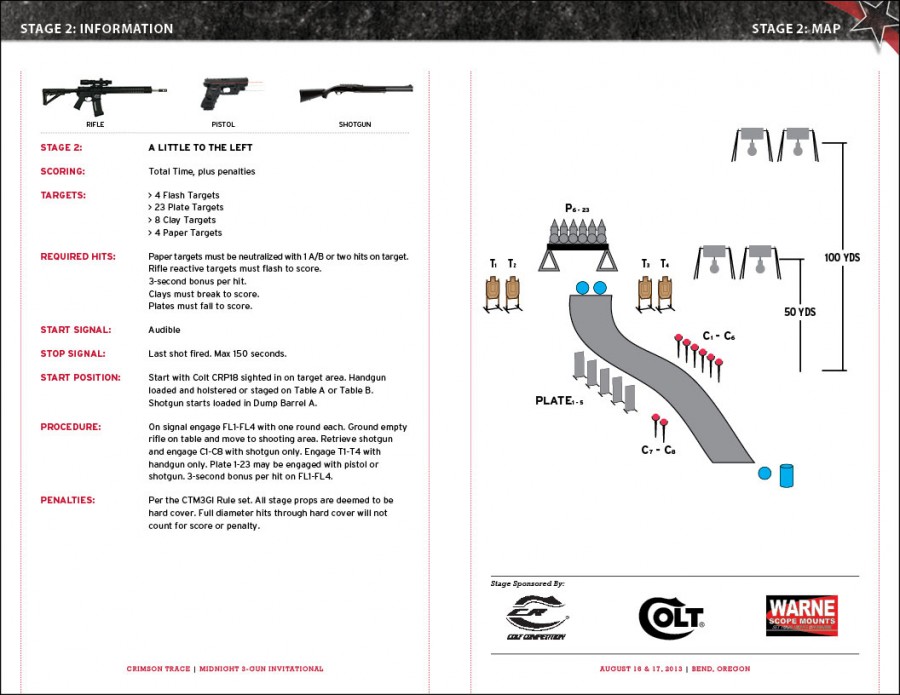The first night of the Crimson Trace Midnight 3-Gun Invitational didn’t end on a promising note. Any time you collect 30 seconds worth of penalties you’re having a bad day. But while that night ended badly, the second and final night was about to start off with a bang . . .
Stage 8 was a straight-up drag race with firearms. There were no real tricks, just finding the fastest way to run the stage. You started with a shotgun, and needed to take out six clay pigeons and 12 steel targets before moving on to 11 paper targets in the neighboring bay. Your handgun started either holstered or staged in front of you in the first bay to finish off the steel targets if needed.
Larry’s plan, and the one that I appropriated for my own use, was to take out the clay pigeons first but keep firing as you swept by the steel targets. As he said, it’s kind of a waste of time to swing past a set of targets without taking a couple shots at them. My plan was to take out the steel targets at the corners, finish off the clays, and then unload the shotgun into the remaining targets. I didn’t have enough shells to completely finish them off, so I would dump the shotgun and pick up the handgun for the rest.
As some of you regular readers may realize, this goes against the pro-shotgun wisdom that we’ve been hearing from El Jefe Larry. His opinion has consistently been that with the “load 2” shotgun loading method, it is quicker to take the time to load the shotgun and get your hits than to try and hit the same targets with a handgun. But as he said, at the distances we were shooting, the handgun was actually the better choice.
In the end, Larry was right. I absolutely gunned it for this stage, moving my fat ass as fast as it would fly down the course and pulling the trigger as fast as I could get the sights aligned. And for my sweat, I was rewarded with a 16th place finish on the stage.
My score was 35.93 seconds. Larry Houck ran the same stage in 38.21.
I had beaten Larry, but that was only on a single stage. The trick is to do that well on all of the stages. And on the very next stage, I was about to slip back into my 50th place pace.
Stage 9 was the last stage on the paper, but the second stage for us to shoot the second night. After hosing some targets with a full auto SCAR and then hitting a car with the grenade launcher, you grabbed your handgun and gunned it for some paper targets. Then, a string of steel targets and clay pigeons awaited for your shotgunning pleasure. A straightforward stage, and one deserving a straightforward plan.
The only glitch in my run of this stage was that one of the steel targets hadn’t been reset. So when I went to shoot the steel, I only counted seven steel targets instead of eight. It made me hesitate for about 4 or 5 seconds and look around for the target I missed, which dragged my score down a bit. It also interrupted my whole “zen” mindset thing, which threw me off a bit for the clay pigeons and caused me to mis-time my reload and force me to do a standing reload from an empty gun. Not cool.
Although I gotta say, any day you get to shoot a grenade launcher is a good day.
Stage 1 was WAY the hell down on the other end of the range, probably a good mile away. Thankfully there were people willing to let me hop a ride over.
The stage design was straightforward, but for this stage the ground was what made it difficult. The high desert conditions in the Bend area meant that the ground was basically a fine sand of some sort, and anytime you so much as looked at it a large dust cloud was generated. For the previous stages, you didn’t move around much so it wasn’t a problem, and the wind carried most of the dust away. But the wind had died, and the dust was heavy. So heavy, in fact, that it only made things worse to have a brighter flashlight. This is why I ran the stage without a headlamp — just so I was able to see what little of the targets I could.
The interesting option on this stage was which of the dump barrels you were going to use to stage your pistol. Some of the competitors’ shotguns were starting to malfunction, so having a backup gun was essential. Staging it on the far table near the last plate rack was the obvious choice, but what if the shotgun took a dump before you got there? You would need to run all the way down and then all the way back, trying not to break the 180 the whole time. The smarter move was staging it on the dump barrel in the middle of the stage, giving you a 50/50 chance of being near the gun if your shotgun died.
The stage ran acceptably well for me, with the exception that my shotgun didn’t fire the first time I pulled the trigger. And as we’ll see in a moment, that was only the harbinger of problems to come.
The final stage. The very last one. Stage 2.
By this time, we were all exhausted. Even thought I had started the night with a full 8 hours of sleep under my belt, I was physically and mentally drained. I was praising my good luck that we had a straightforward stage to shoot, but cursing the difficulty of the props on the course.
Everything was pretty straightforward right up until the very last target: a triple plate rack of decreasing surface area. It’s an evil target designed by the Devil himself, and one that I was not going to tackle using a handgun. I loaded every last shotgun round I had left into my gun, and strapped a full box of shells on my body that I borrowed from one of the other competitors. It still wouldn’t be enough.
When I went to start the clay pigeon section of the course, my shotgun refused to run. It wouldn’t fire, then it wouldn’t eject the spent cases, then it wouldn’t cycle the action. But when the gun warmed up, the thing ran perfectly. Except that I had now dumped a bunch of shells doing malfunction clearing.
The reason for the issues was something that is unique to nighttime 3-gun competitions: the dew point had just been reached. Every droplet of water vapor had suddenly fallen out of suspension in the air and accumulated on our guns, making them wet and turning the thick coating of dust into a thick coating of mud. It made the guns jam, and was a massive pain in the ass.
At the far end of the stage, I was now facing the plate rack low on shotgun ammo. I emptied the gun, but it wasn’t enough – there were plates left standing. And I knew I was screwed.
I switched to the handgun and took out the remaining large plates, then hit the paper targets and went back to try and get the last few plates. I knocked one over, but the other two refused to go down. After about a magazine and a half, I gave up. I already knew that I had wasted WAY more time than I wanted to trying to get them over, and I was willing to take the hit in terms of a miss rather than keep trying and potentially “time out” on the stage. It was a trade-off that I didn’t want to have to make, but when your only indication of the point of aim of your handgun is a laser that may or may not be experiencing some parallax issues, I didn’t want to take the chance.
At the end of the day, I had finished in a fairly respectable position. I came in 58th out of 144 shooters, and 1st place out of all the writers and other media at the event. And if you look at the scores online, I placed right around the guys from Top Shot – two points behind Chris Cheng, and within 10% of Chris Cerino and Mike Hughes. To put that in perspective, I would have beaten them if I didn’t take on that 30 second penalty on the first night.
Considering that the Crimson Trace Midnight 3-Gun Invitational is only open to the very best shooters in the sport, I’m pretty happy with a 58th place finish. Not overjoyed, but reasonably happy. But what really lights my fire is that 16th place finish on Stage 8. Now that I know I’m capable of running at that level, I want to be able to do that well every stage. Thankfully, there are still some competitions left this year where I will have the opportunity to try again.








Good job Nick! These write-ups are always my favorite articles on TTAG.
Comments are closed.